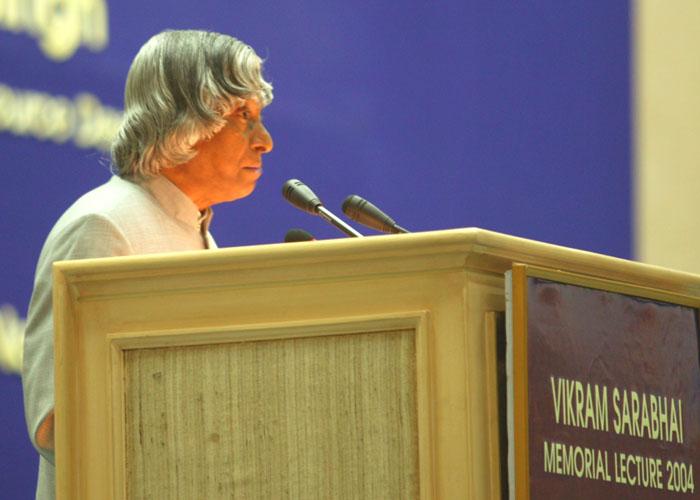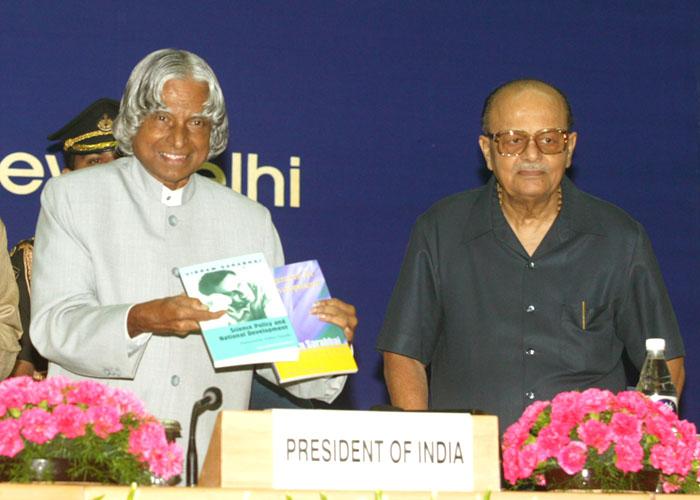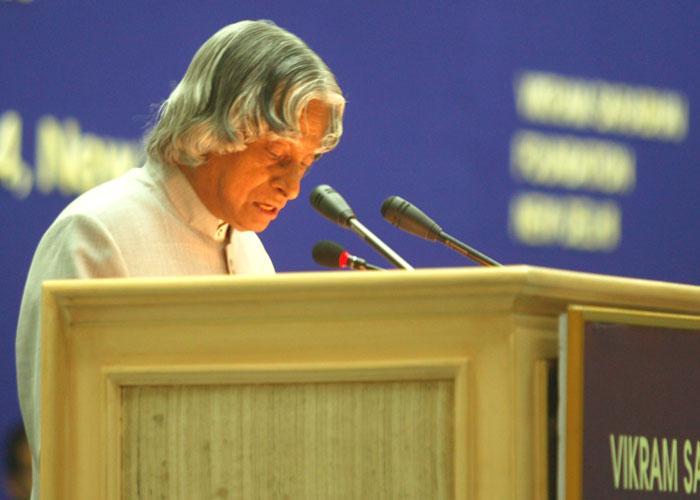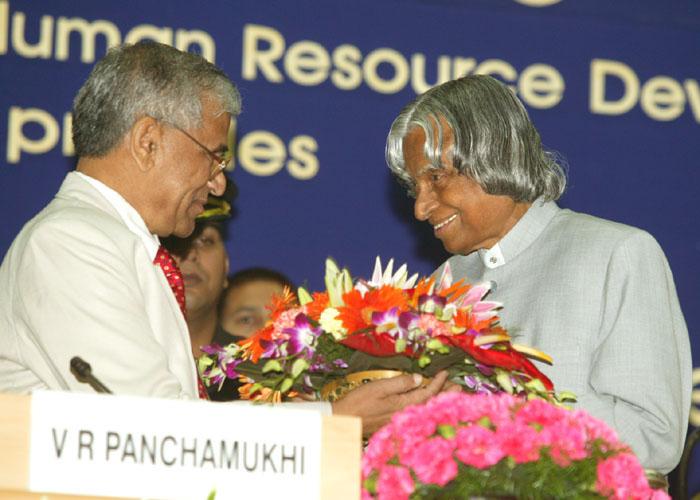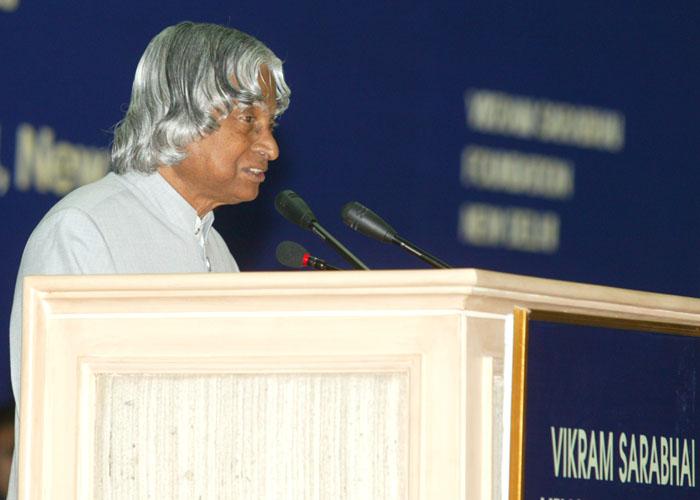Vikram Sarabhai Memorial Lecture-2004
New Delhi : 12-08-2004
Dynamics of Societal Transformation
I am indeed delighted to participate in the Vikram Sarabhai Memorial Lecture organized jointly by Indian Council of Social Science Research (ICSSR) and Dr. Vikram Sarabhai Foundation. I greet the organisers, members of the foundation, distinguished guests and friends. I was thinking on this occasion what thoughts I can share with you. The topic I have chosen is Dynamics of Societal Transformation.
Leadership Challenges
Generation of creative leaders is a big challenge. It happened in the society at difficult times or in a prosperous time. The creative leadership can be defined as follows:
Creative leaders are those whose leadership styles move from commander to coach, manager to mentor, from director to delegator and from one who demands respect to one who facilitate self-respect.
I have studied, experimented and benefited from the works of three great human beings at various faces of human life. They can be classed as creators of a creative leader who think different and ahead. I am not going to equate one to the other. But I would like to share the beautiful aspects I have learnt.
Thiruvalluvar:
One visionary who gave the code of conduct for the whole universe, 2200 years ago is poet Saint Thiruvalluvar. A study of Thirukkural reveals the fact that Thiruvallur?s work is beyond any boundaries, beyond any religion, beyond any culture and provides a path of righteousness for the mankind and it is valid even today. In any of the 1330 kurals, he had not mentioned about any religion, any region, any language, any culture, any country but all his work is towards how to build a happy, humane and righteous life in the society. I would like to highlight two of the couplets about the typical characteristics of indomitable spirit of a creative leader.
Let us study the characteristics of indomitable spirit. It has two components. The first component is that there must be a Vision leading to higher goals of achievement. This thoughts itself leads to high thinking.
Quote:
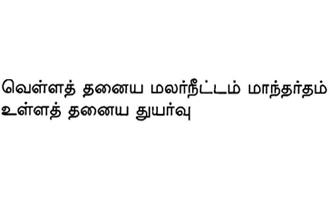
It means that whatever may be the depth of the river or lake or pond, whatever may be the condition of the water, the lilly flower always comes out and blossoms. Similarly, if there is a definite determination to achieve a goal even if it is impossible to achieve, the man succeed fully or goes near the mission.
Many of us have gone through large programmes and projects. We would have experienced that success is not in sight and there are many hurdles. The same poet reminds us at this point of time through another couplet:
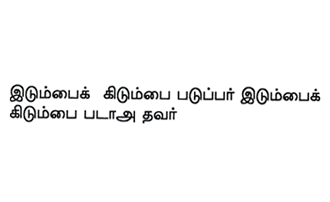
It means successful leaders can never be defeated by problems. They become master of the situation and defeat the problems. I consider these two Thirukkural characterize the indomitable spirit of a creator of creative leaders. He was a source of inspiration for the whole mankind.
Mahatma Gandhi
We saw the Ahimsa Dharma again in a great human being, Mohandas Karamchand Gandhi, in the 20th Century, when he started the freedom movement. He fought for freedom with peaceful means of non-violence. He became 'Mahatma' for the movement that he started against oppression and racial discrimination in South Africa. This movement has become a forerunner for many such movements all over the world. The world saw, for the first time, the ahimsa dharma in full-fledged action leading to freedom and peace. Mahatma Gandhi had the capability of creating leaders like Pandit Jawaharlal Nehru, Sardar Vallabhbhai Patel, Maulana Abul Kalam Azad, Khan Abdul Ghaffar Khan, Sarojini Naidu simultaneously during the mission of independence movement in India.
Another incident I would like to narrate about Mahatma Gandhi is that of 16th August 1947. On that day in the Tamil newspaper, on the front page, two news items appeared. One item was India achieving freedom and Panditji?s speech. The other news item and the most important one which has been embedded in my memory is about Gandhiji walking barefoot in Kolkatta, removing the pain of riot-affected families. Normally as Father of the Nation Mahatma Gandhi has to be the first to unfurl the national flag on August 15, 1947 in Red Fort. But he was not there at the Red Fort, instead he was at Kolkatta. Mahatma Gandhi was an embodiment of nobility, elevated thinking and concern for human beings. What a great leadership of this noble personality and that is why he is acknowledged as a millennium leader of 20th century.
Dr. Vikram Sarabhai
The Scientific leader with whom I was fortunate to work with was Dr Vikram Sarabhai. He had a special ability of spotting prospective dynamic leaders and entrusting them with challenging tasks in science and technology. He always used to give them task which has not been accomplished before and gave them limited resource and time. This made the scientists to strive hard and achieve unusually high performance. Once the task has been done he used to review the task personally along with renowned specialists in the field. This not only motivated the scientists but also ensured that the quality of the scientific achievement was excellent. Once achieved he used to give higher and more complex targets. This continuous higher-level demand on the scientists created an excellent work culture among them. Having tasted extraordinary success they would never be satisfied with moderate performance. Thus through the process of rigorous selection, fixing of challenging objectives to be achieved and a transparent evaluation system he created extraordinary scientific leaders in many fields.
His unique way of creating leaders is that he had generated a healthy competitive environment. He gave a very important development mission to build cost effective meteorological rockets for three of us. I was given Menaka Rocket, Muthunayagam was given RH-125 and Y.J. Rao was given RH-100. Finally, based on the experience of all three developmental programmes, a new meteorological rocket emerged, called RH-200. Like that many technology tasks were accomplished in record time by his inspirational leadership. Dr. Vikram Sarabhai was a great scientific thinker in the post independent India and shaped the scientific rhythm and destiny of our nation. He was a multi-faceted personality - great visionary, distinguished cosmic-ray and space scientist, institution builder, industrialist, management expert, educationist, great lover of arts and above all an enlightened citizen. It was the vision of Dr. Vikram Sarabhai, which gave shape to India?s Space Programme, provided a strong foundation and led India to a very strong position in launch vehicle, satellite and space technologies and their applications. It was he who enunciated the need for space application to the society and gave a space profile for ten years.
High Technology for Societal Development
In 1964, Dr Sarabhai declared ??. To us there is no ambiguity of purpose. We are convinced that if we are to play a meaningful role nationally and in the community of nations we must be second to none in the applications of advanced technologies to the real problems of the man and society?. Thus he saw a golden opportunity to harness space science and technology to the development of the country in the fields of communication, meteorology, remote sensing and education. He launched multiple programmes and introduced innovative approach to acquire competence in advance technology based on technical and economic evaluation of their real resources. Sarabhai was responsible for launching the Satellite Instructional Television Experiment (SITE) during July 1975 - July 1976. This made revolution in the connectivity of rural areas.
Dr Sarabhai was always ahead and a creator of creative leaders whose demeanour was a lesson itself. Nine years effort of Dr. Sarabhai and his team in building space technology is equivalent to twenty-seven years of hard work, which enabled our country to be on par with advanced countries. Some of the traits of Dr Sarabhai, that helped India, were his vision, ability to think ahead of his peers, team spirit and encouragement of healthy competition in scientific research.
Friends, on this very important occasion of remembering Dr. Sarabhai, my guru and one of the great visionaries of the nation, I would like to present the thoughts and vision put forth by Dr.Sarabhai that resulted in evolution process for ?societal transformation? and more importantly creation of a large number of creative leaders.
Application of Space Technology in Education
For any nation, the level and quality of education is one of the most significant parameters for development. In India, the total literacy has gone up over the years but the quality needs tremendous improvement. The synergy between education and learning has to be well perceived and operationalised. Education is essentially an aid to generate worthwhile learning, while learning itself is ultimately an individualized and lifelong process, whereby human transformation occurs within the individual. Learning has various forms such as: pre-learning, reinforcement of learning, classroom learning, individualized and independent learning of small groups or large masses, enrichment learning, self-learning and self-directed or self-managed learning. Final result of learning is the application of knowledge and skills by the individual for the benefit of the society, nation and the world. Recently, I inaugurated a conference of Vice Chancellors on the EDUSAT organised by ISRO. The prime objective of the EDUSAT programme is to provide support to education through low-cost ground segments and to reach the un-reached people of India in every nook and corner. EDUSAT (GSAT-3), the first satellite of the Education Satellite System, will be launched by the third flight of the indigenous launch vehicle GSLV in last quarter of 2004. The satellite is specially configured to have multiple beams covering different regions of India. This is a satellite operating in Ku-band frequency facilitating the use of easy to handle small transmit/receive ground terminal. It provides communication coverage through five regional beams and a national beam. It will also provide full Indian coverage including the Indian islands in C-band.
A multi-pronged approach for Tele-Education
A three-pronged approach is essential to make distance education programme viable and a successful proposition through the universal tele-education system to all remote parts of the country. The three components may be the Connectivity, Tele-Education System and the Quality Content Generation and deployment.
Connectivity:
One-lakh fifty thousand ground terminals in its full capacity. The other parts of the country have to be covered by providing Broadband and Wireless communication network in an integrated fashion. Terrestrial optical communication is becoming cost effective and can complement the space communication with its low cost, high bandwidth and networking capability. An integrated networked system comprising EDUSAT, Broadband and Wireless networks should provide a highway for reaching quality education to all parts of the country.
Tele ? Education System:
Once we have the connectivity, then there should be a universal tele-education system in place for making full utilization of the connectivity to bring virtual classrooms in a multi class environment with seamless two-way interaction between the teachers and students in a collaborative environment. This system should not only enable the lecture delivered from the Studio at the university to reach any remote corner but also enable a good teacher in the remote area to provide multicast information to other participants of the programme. This type of tele-education will assist in areas where there is shortage of good teachers.
A Tele-Education delivery system:
I would like to narrate our experience in tele-education piloted at Rashtrapati Bhavan for providing satellite connectivity for the PREVIK (President?s Virtual Institute for Knowledge) members. The connectivity is through V-SATs provided by ISRO, Voice Over-IP and Internet. In this platform, the live virtual studio environment is created and it will connect a number of remote locations and provides seamless, one to many connectivity, through multicasting mode in a collaborative environment. This also provides two-way connectivity. In this platform, I can give a presentation and address the remote locations, where the multimedia delivery is possible and also I can interact through various collaborative tools. I can refer any informational website from Internet to all the remote locations and can also delegate the remote expert to give a lecture to all those who are connected. We have also established the Digital Library and digitized around 2 million pages. I can search for a particular page and push the page to all the participants through this tele-education. It is an integrated solution, which makes me feel as if I am virtually connected to all participants in multiple locations. In the present context with respect to universities, EDUSAT provides the connectivity. An integrated Tele-education delivery mechanism is available and being used. What is required now is the generation of quality content for sharing and transmitting to remote students.
Virtual University
It is time that we should start looking at the possibility of creating a Virtual University in India through networking of all the universities and other educational institutions for imparting universal tele-education. Virtual university will have the following tasks:
Act as a central hub of all universities, which are networked.
Identify experts of national/international eminence in specialized areas and nominate institutions of eminence and teachers.
Coordinate, organize, schedule and broadcast the lecture of specialists at a mutually convenient time to all participants.
Record the live transmission of the lecture with interaction details in a data bank for easy access by participants for review learning.
Digitize all the university libraries and make it available for seamless access by all the universities.
The universities need to become learner centric.
This experiment across the country will provide a common platform for teaching in Schools, Colleges and Universities and even vocational courses. This will give equal emphasis on theory and experiments in spite of the fact that it will be done in the cyberspace. Such is the power of the technology and our understanding of it. This facility would also help in expansion of telecommunication and IT services. All this would lead to synergising the strengths of different universities in promoting quality education to our students in a cost effective manner.
Establishing Village Panchayat Knowledge Centers
India has approximately two hundred thousand village Panchayats. I visualize establishment of village knowledge centers in these Panchayats to empower the villagers with the knowledge and to act as a nodal center for knowledge connectivity for the villagers. These knowledge centers may be connected to the Universities through tele-education.
This Center may be equipped with 1000 books of different subjects. In addition the center can have facility for reading the text in digital library with an audio output so that people, who are unable to read, can benefit from the library. The knowledge center can also be used for collection, digital storage and dissemination of village specific information pertaining to agriculture, craftsmanship, arts, artisan techniques, informal judicial system practiced in village, based on values, local remedies for simple ailments, village stories with moral values, village history, village folk songs, village cultural traditions, traditional medicinal practices followed in villages and village marketing information and methods. Such information presently is being transmitted through word of mouth and with changing generation, it is being lost.
It is essential to preserve and carry forward this knowledge base for the benefit of future generations. This village panchayat knowledge centers will become a help desk and confidence builder for the villagers. In course of time, there could be inter panchayat information transfer leading to assured information flow to the needy. Universities can play an important role for establishing the village knowledge centre with the use of EduSat Ground segment. Village knowledge centre has to become part of rural development programmes.
Emerging new fields ? Nano, bio, information and space technology
The national developmental challenges are many involving integrated action namely: Agriculture and Food Processing, Education and Health care, Information and Communication Technology, Infrastructure and self-reliance in critical technologies. As space technologists have the role to play in many areas like education, healthcare, disaster prevention & mitigation, e-governance, urban planning, rural communication, PURA (Providing Urban Amenities in Rural Areas) etc. The future of space applications for the planet earth cannot be only in the expanded uses of the now-very conventional technologies for telecommunication and space imagery.
Integrated application of space technology with other technologies such as biotechnology, information technology and Nano-technology is emerging for new missions. The innovative missions must address pro-actively acute problems of rapid depletion of conventional energy sources, drinking water supplies, and deliver solutions for the man-planet conflict that has led to pollution, climatic change and degradation of ecology and the environment. Our scientists must work together for making these societal missions a success in a time bound manner using multiple technologies. Scientists and Technologists working together on mission mode will be a good tribute to Dr.Sarabhai.
Cluster of satellites for Remote Sensing and GPS
While ISRO has specialized in remote sensing satellite technology, it has to increase the number of satellites in polar orbit to reduce revisit time for the same location within 30 minutes. Of course over a period of time, India has the capability to launch multiple satellites with higher resolution cameras to meet this requirement. But, considering the varying climatic conditions in a large country and better utilization of Indian and foreign remote sensing satellites, it is essential to have an international partnership for orbiting cluster of satellites with Synthetic Aperture Radar (SAR) capability. This will reduce the overall expenditure and time, giving maximum benefits at the earliest for both the partners. Similarly, we need a cluster of satellites for Global Positioning System. This will be possible with international partnership. The urgent need is to design and develop a variety of fully reusable RLV technology demonstrators and thus give credibility to the whole concept of low cost access to Space.
I visualize in the year 2050 world organizations in space technology establishing a habitat in Mars, mining industrial units in planets & moon and build the capability to destroy or deviate the asteroids when the earth is endangered. India has to participate in such challenging mission with other countries. Thinking beyond our planet is an essential trait. The thought itself elevates the person. The person is transformed into a creative state. Creativity indeed is the foundation of discovery and inventions.
Conclusion
Dr. Vikram Sarabhai envisioned that the benefit of science and technology must reach the rural population, in order to make India a prosperous nation. We have rich natural resources, highly skilled manpower, many success stories in various fields including science and technology, health care, agriculture, defence and ICT sectors. But, what is needed is from having a sustainable development and the benefits reaching the rural people? If we can connect the successes in an integrated manner and with the earlier experience certainly the future is ours.
Saint Thiruvalluvar?s work took place when the region he lived was very prosperous in thinking and wealth. Mahatma Gandhi appeared in the scene when there was a foreign ruler in India. Dr. Vikram Sarabhai, a scientist and visionary lived almost equal part in British India and free India. He realized that freedom alone will not bring happiness to the society, wealth has to come and the society has to have economic prosperity. Achieving future economic prosperity should come in for the total population of the country.
Now the question comes, in the present dynamic situation of India, will the creators of creative leaders emerge? Poetically, I can say that when the horizon is fully red or fully green, creator of creative leaders appear in the horizon. I believe and I am sure that this is the time, creators of creative leaders will emerge for eliminating poverty and diseases and establish a peaceful nation and there by the world.
May God bless you.

